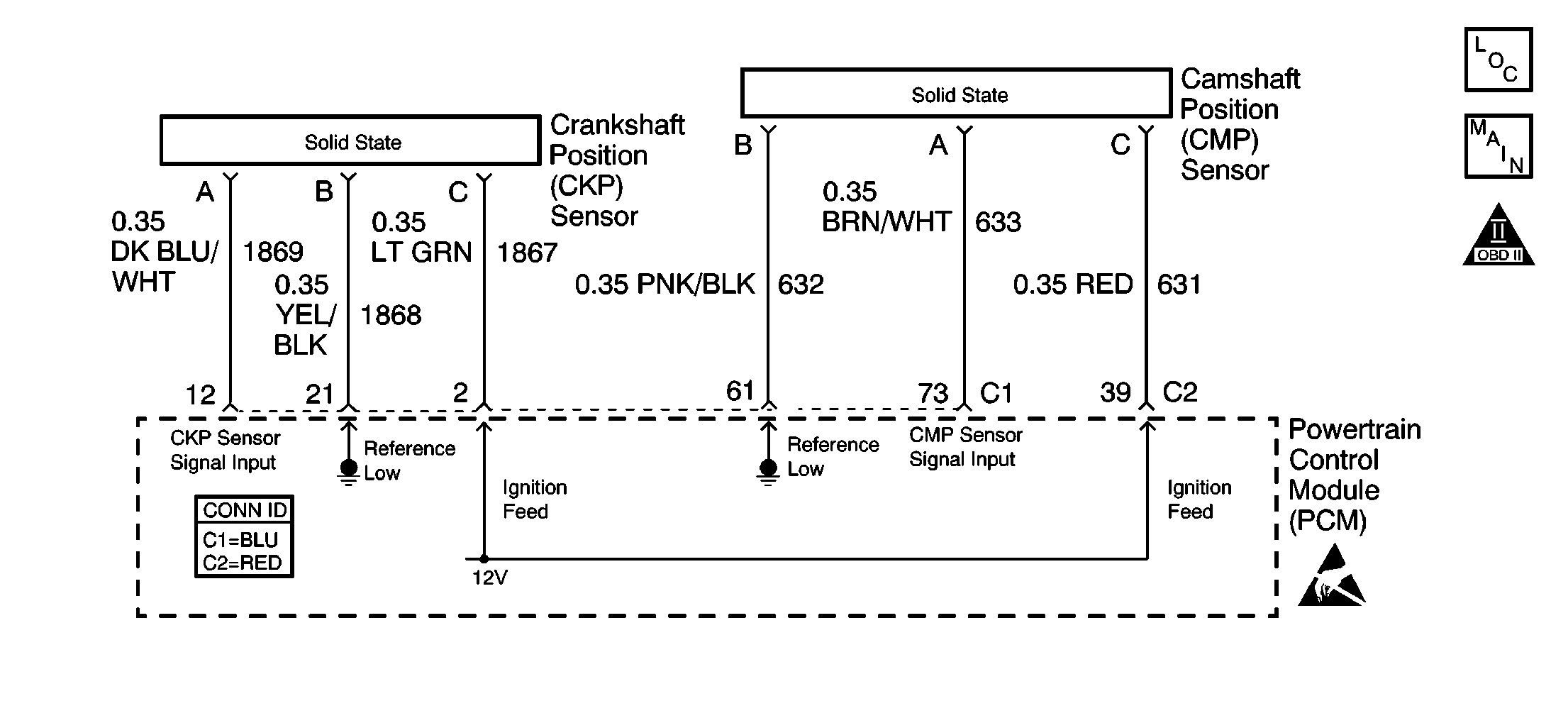
Circuit Description
The Crankshaft Position Sensor is mounted in the right rear of the engine block behind the starter. The CKP sensor works in conjunction with a 24X reluctor wheel mounted on the rear of the crankshaft. The CKP sensor has a B+ power supply, a ground, and a signal circuit.
As the crankshaft rotates, the reluctor wheel teeth interrupt a magnetic field produced by a magnet within the sensor. The sensor's internal circuitry detects this and produces a signal which the PCM reads. The PCM uses this signal to accurately measure crankshaft velocity which is a variable used in order to detect misfire, and control spark and fueling.
Conditions for Running the DTC
The engine is operating.
Conditions for Setting the DTC
The PCM determines that the CKP sensor signal is out of range for less than 1 second.
Action Taken When the DTC Sets
| • | The PCM illuminates the malfunction indicator lamp (MIL) on the second consecutive ignition cycle that the diagnostic runs and fails. |
| • | The PCM records the operating conditions at the time the diagnostic fails. The first time the diagnostic fails, the PCM stores this information in the Failure Records. If the diagnostic reports a failure on the second consecutive ignition cycle, the PCM records the operating conditions at the time of the failure. The PCM writes the conditions to the Freeze Frame and updates the Failure Records. |
Conditions for Clearing the MIL/DTC
| • | The PCM turns OFF the malfunction indicator lamp (MIL) after 3 consecutive ignition cycles that the diagnostic runs and does not fail. |
| • | A last test failed, or current DTC, clears when the diagnostic runs and does not fail. |
| • | A history DTC clears after 40 consecutive warm-up cycles, if no failures are reported by this or any other emission related diagnostic. |
| • | Use a scan tool in order to clear the MIL and the DTC. |
Diagnostic Aids
Important:
• Remove any debris from the PCM connector surfaces before servicing
the PCM. Inspect the PCM connector gaskets when diagnosing/replacing the PCM.
Ensure that the gaskets are installed correctly. The gaskets prevent
contaminant intrusion into the PCM. • For any test that requires probing the PCM or component
harness connectors, use theJ 35616
connector test adapter kit. Using this kit prevents
any damage to the harness connector terminals. Refer to
Using Connector Test Adapters
in Wiring Systems.
The following conditions may cause this DTC to set:
| • | Poor connections: Refer to Testing for Intermittent Conditions and Poor Connections in Wiring Systems. |
| • | Crankshaft reluctor wheel damage or improper installation. |
| • | The sensor coming in contact with the reluctor wheel. |
| • | The engine running out of fuel. |
| • | If the crankshaft rotates backwards, this DTC will set. This condition is only with vehicles equipped with a manual transmission. This condition can occur when a vehicle is on an incline and the clutch is released and an engine stall occurs. |
Excess crankshaft end play causes the CKP sensor reluctor wheel to move out of alignment with the CKP sensor. This could result in any one of the following:
| • | A no start |
| • | A start and stall |
| • | Erratic performance |
For an intermittent, refer to Symptoms .
Test Description
The numbers below refer to the step numbers on the diagnostic table.
-
This step verifies that the malfunction is present.
-
This step tests for EMI (Electro Magnetic Interference) on the CKP sensor circuits.
-
Vertical lines across the face of the sensor could indicate foreign material passing between the CKP sensor and the reluctor wheel. Non vertical lines across the face of the sensor may indicate a crack in the CKP sensor. Either of these conditions causes this DTC to set.
-
Damage to the reluctor wheel would affect the CKP sensor output. To inspect the reluctor wheel, remove the starter and rotate the crankshaft while viewing the reluctor wheel through the CKP sensor hole. If you cannot determine if the reluctor wheel is damaged, the oil pan may have to be removed. If this condition exist, refer to Engine Mechanical for crankshaft replacement.
Step | Action | Value(s) | Yes | No | ||||||
|---|---|---|---|---|---|---|---|---|---|---|
1 | Did you perform the Powertrain On-Board Diagnostic (OBD) System Check? | -- | ||||||||
|
Important: If DTC P0335 is also set, diagnose DTC P0335 before proceeding with this DTC.
Does the scan tool indicate that DTC P0336 failed this ignition? | -- | Go to Diagnostic Aids | ||||||||
Did you find and correct the condition? | -- | |||||||||
4 |
Did you find and correct the condition? | -- | ||||||||
5 |
Did you find and correct the condition? | -- | ||||||||
|
Important: The CKP System Variation Learn Procedure must be preformed anytime the relationship between the CKP sensor and the CKP reluctor wheel is changed. Refer to Crankshaft Position System Variation Learn .
Is the CKP sensor damaged? | -- | Go to Crankshaft and Bearing Removal in Engine Mechanical-5.7L | ||||||||
Inspect the crankshaft reluctor wheel for damage. Is the reluctor wheel damaged? | -- | Go to Crankshaft and Bearing Removal in Engine Mechanical-5.7L | ||||||||
8 |
Is the action complete? | -- | -- | |||||||
9 |
Does the scan tool indicate that this test ran and passed? | -- | ||||||||
10 | Select the Capture Info option and the Review Info option using the scan tool. Does the scan tool display any DTCs that you have not diagnosed? | -- | Go to the applicable DTC table | System OK |
